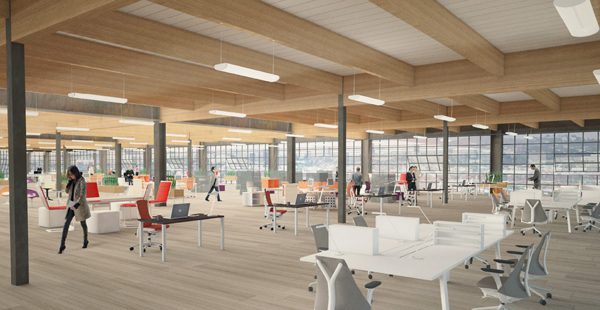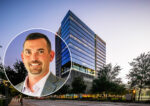Trending
[Over]supply and demand

There’s healthy demand for office space in Greater Los Angeles right now, but the risk of overbuilding is real, insiders say. As of the third quarter, more than 1.5 million square feet of office space was under construction, according to a CBRE report.
Around 7.4 million square feet of new office space in Greater L.A. will be completed by 2020, according to Cushman & Wakefield. And in the next year, 1.6 million square feet of office space under construction will be delivered in Downtown L.A., which already has an 18.2 percent vacancy rate, according to data from the Downtown Center Business Improvement District.
The rental rate in L.A. County was $3.18 per square foot in the third quarter of 2017, according to Cushman & Wakefield.
Culver City had one of the highest vacancy rates in the county (27.7 percent) according to JLL’s third quarter report, but that’s due in part to a wealth of new construction underway that the firm has factored into the area’s vacancy rate. NKF put Culver City’s vacancy rate at 21.1 percent in the third quarter.
Even the most bullish experts are beginning to admit that L.A.’s high vacancy level, coupled with a glut of new office space, could lead to a softening in the market. And there may be even more vacant space than the reports indicate. Some commercial real estate brokerages do not track conversions — which are existing buildings converted from a previous purpose like warehousing to office space — until they are available to lease, which means this currently “invisible” space could cause the number of vacancies to rise sharply when they are completed and suddenly available.
JLL and Newmark Knight Frank don’t include conversions in their numbers, but Cushman & Wakefield noted that about 3.3 million square feet of office space was under “renovation” into creative office space in Greater L.A. in the third quarter. Cushman & Wakefield listed 1.5 million square feet under construction in the third quarter. Separately, the firm counted 3,387,529 square feet as being under “renovation” into creative office space in Greater L.A.
“[Office space conversions that are not complete] can be tricky for any of the firms to capture, in terms of square feet,” said Eric Kenas, a research market director at Cushman & Wakefield.

Eric Kenas
When evaluating areas that have substantial amounts of new inventory in the construction pipeline, not accounting for converted office space makes it nearly impossible to accurately forecast the future of rents and vacancies.
“Maintaining the integrity of the data for building inventory is important, more so in Downtown L.A.,” Kenas said. “This is the largest area of divergence, according to the latest market reports.”
Although industry experts say it’s common for brokerages to follow their own methodologies to track office space inventory — and include or exclude certain types of statistics — this can make a consensus on the health of the market difficult to reach.
Downtown Los Angeles office space is 39 percent occupied by legal, financial services and insurance firms, according to JLL’s 2017 second quarter report. Much of the remaining share is comprised of “legacy industries” such as oil and gas, government and accounting, which have occupied DTLA for decades, according to the brokerage. This is likely to change as creative office space conversions begin to take up more space, but experts predict leases may lag as tenants have an increasing choice of spaces.
“Downtown does have a higher vacancy level,” said Nico Vilgiate, executive vice president of Colliers International. “But it’s by no means the end of the world. We’ll see DTLA space lease quickly. All you have to do is look to Warner Music,” Vilgiate said, in reference to the company signing a lease in the Arts District in 2016 before the building they were to inhabit was completely renovated. “Do I think every one of these adaptive reuse projects will get preleased? No, but I know for certain new leases will start chipping away at overall vacancy. That’s why I’m feeling optimistic.”
New tenants will need to materialize steadily through much of 2018 to keep the office market balanced. Cushman & Wakefield’s second quarter 2017 office report forecasts that Greater L.A.’s office vacancy rate will hover around 14 percent through 2019. Industry sources agree that an influx of new inventory will deliver at a time when broader job creation is slowing.
Cities with tech-driven submarkets like L.A. are experiencing a shortage of skilled employees in the technology sector. New jobs will be created at a markedly slower pace than in the recent past due to the struggle to find workers, according a Cushman & Wakefield report that cites Oxford Economics and Moody’s Analytics. From 2014 to 2016, Los Angeles ranked 16th in the world for job growth, with 939,000 office jobs created during that time. The firms estimate that L.A. will fall to the 20th spot with 68,800 new office jobs to be created from 2017 to 2019.
Soylent, the maker of a liquid meal replacement, may soon staff up in Los Angeles. With a $50 million investment in Soylent by Google’s venture capital division — bringing Soylent’s total fundraising to nearly $75 million — more jobs are on the horizon to support the company’s marketing and distribution efforts.
 In the second quarter of 2017, Soylent expanded its footprint by leasing 290,000 square feet of office space in At Mateo, an $80 million retail and office complex under construction at 555 Mateo Street, in the Arts District. According to industry insiders, the lease may replace the company’s current and smaller location. The lease was slightly under $4 a square foot per month for the space, which is expected to be complete by the end of this year.
In the second quarter of 2017, Soylent expanded its footprint by leasing 290,000 square feet of office space in At Mateo, an $80 million retail and office complex under construction at 555 Mateo Street, in the Arts District. According to industry insiders, the lease may replace the company’s current and smaller location. The lease was slightly under $4 a square foot per month for the space, which is expected to be complete by the end of this year.
Previously occupied by warehouses, the At Mateo site is being developed by L.A.-based Blatteis & Schnur and ASB Real Estate Investments. The companies jointly paid $32.5 million for the property, according to previous reporting by The Real Deal.
In addition to the Soylent-occupied space, At Mateo has another 70,000 square feet of open, creative office space with 15-foot exposed wood ceilings and floor-to-ceiling windows for lease, said a broker familiar with the property.
At Mateo’s opening precedes one of L.A.’s most buzzed-about office projects nearby: the $2 billion, 2.8-million-square-foot mixed-use development dubbed 6AM, which includes a series of mid-rise towers at Sixth and Alameda streets in the Arts District.
Designed by Switzerland-based architecture firm Herzog & de Meuron and developed by Irvine-based SunCal, the buildings will feature 1,305 apartments, 431 condominiums, 412 hotel rooms and 253,514 square feet of offices that will face Alameda Street.
The 14.6-acre property also includes 23,000 square feet of gallery space, 128,000 square feet of retail and restaurants and an as-yet unnamed private or public/private hybrid school, as well as a boutique hotel, according to information released by SunCal.
The property is currently occupied by industrial warehouses that will be razed, and a necessary zoning change is pending with the City of Los Angeles; the three-phase project is slated to begin in 2018 for full completion in 2035.
Another notable mixed-use development that includes office space is 631 Vermont, next to the future Korean American National Museum, which will be built on a city-owned parking lot at the corner of Sixth Street and Vermont Avenue in 2018.
The development will demolish a chain restaurant in favor of a 33-story building with 50,000 square feet of office space, along with 200 hotel rooms, 250 condos and 28,500 square feet devoted to retail and restaurants, according to information provided by developer Jia Long USA. Los Angeles-based architect firm Archeron Group is designing the project, which is slated to begin in late 2017 and conclude by 2020.




